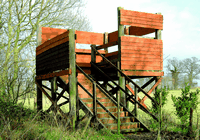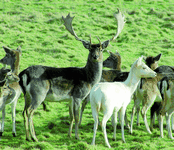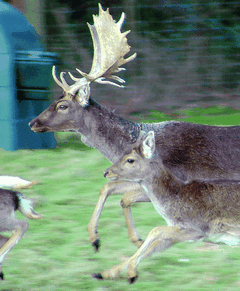College Farm Focus:College Deer Park proves a useful diversification

Alongside our traditional agricultural students, growing numbers are studying gamekeeping and wild deer management, making a farmed deer herd an obvious opportunity for diversification at Easton College.
During 2000 a National Diploma Countryside Management group wrote an assignment evaluating whether a deer park could be established in 2.8ha (7 acres) of under-used land lying on light sandy soil. Fortuitously, this was submitted as a proposal to the college senior managers at a time when a grant of £10,000 was available from the “Standards Fund for Teaching” and it was agreed that the deer park should be given the go-ahead.
Help and advice was given by two notable local deer enterprises. The first was Todd Bruno from Houghton Hall, home of Lord Cholmondeley and famous for it’s all white-coloured fallow herd and its work on genetics using pure-bred stock from Sweden, Hungary and Denmark.
The second was James Ellis from Gunton Park, a designated conservation area with many historical and royal connections and where the bucks’ antler quality is truly exceptional.

Set-up
The does were supplied by Houghton and the bucks came from Gunton. The fencing was constructed by professional contractors and my advice would be that specialist deer fencing is not cost-effectively erected by the amateur. Put simply, posts rammed in last longer than those dug in, due to their resistance to rotting or slackening. The entire set-up, including the does and two bucks, cost the college £7300.
On less than 40.5ha (100 acres) deer would seldom be profitable as fencing costs per acre fall as the area gets bigger. But we can cover our running costs on an annual basis by the sale of venison, which has to go as “park and wild”, since we have no expensive facility to handle or load deer. The implication of this is a significantly lower price, since the age and condition of animals is variable and sale is through a game dealer at the lowest prices in the venison range.
Post foot-and-mouth prices for venison in this category slumped as low as 40p/kg. If we could handle them and read ear tags we could monitor liveweight gains, birth percentage and kill weights and market meat as premium quality.
Furthermore, assurance schemes require abattoir slaughter, which in turn requires the ability to load live animals. The net result for us is that annual costs (fertiliser application and a small amount of supplementary winter feed) were barely covered.

Simple
Sales of venison are growing as it is recognised as a healthy red meat (with high protein, 1% fat and free from saturated fatty acids), which is produced in a welfare friendly manner.
Our management system is as simple as any livestock enterprise could be. During June students walk the Deer Park daily to capture and tag as many newborn fawns as possible.
Each year’s crop of fawns is ear tagged with different coloured tags which informs later culling. Some winter feeding is necessary.
However we try to manage the herd so that the grass remains the principal source of food.
Animals to go for venison are culled using a rifle from a specially erected shooting tower and it has been amazing how this can be achieved with almost unnoticeable stress to the remaining animals.
The technique involves getting deer used to being fed on a drizzled bag of food so that they form a straight line from which a marksman is able to select and cull an appropriate animal. The lack of reaction from other animals is quite remarkable.
Does are culled at 12 years automatically and youngstock kept to replace them. All other home-bred animals are culled at 18 months, processed by gamekeeping students at the college who are undertaking their Game Meat Hygiene training and sold through a local game dealer.
| FALLOW DEER |
| Fallow deer were found in Britain before the Ice Age, but died out during the Ice Age and were probably reintroduced when the Romans husbanded them here. But widespread reintroduction is generally credited to the Normans, who hunted wild fallow deer extensively. Many regional populations can be traced to historic deer park escapees. Fallow are widespread and numerous in the wild. In many counties their numbers are considered to be damaging to flora and natural fauna. They produce a single fawn in May/June 31-32 weeks after the rut. Fawns are weaned after 7-9 months. |
In deer farming the financial return itself is often dependent on a secondary aspect of the business, for example tourism, direct sales from the farmgate, or live sales of breeding stock. In our case, as a college, our aim is to provide outstanding teaching resources which cover their own costs. However, outputs could be more directly marketed if the scale of operation justified it.

As a teaching resource where husbandry is challenging and as an “attraction” to the many school and day visits which Easton College receives the success of the enterprise has been unrivalled and these fascinating and graceful animals add diversity to our curriculum.
| WILD VENISON |
|
| FARMED VENISON |
|
Related Links:
